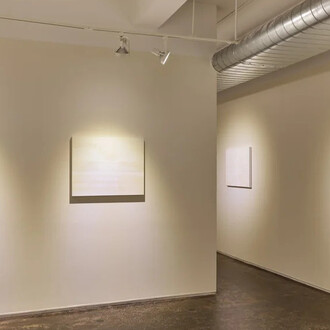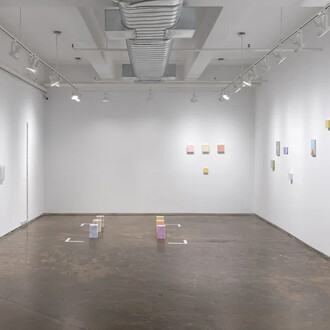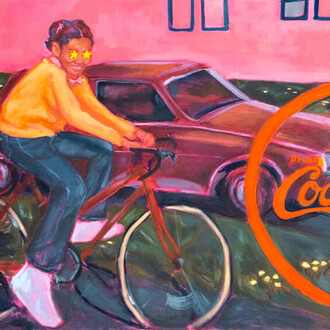A.I.R. Gallery is pleased to announce Shedding My Toxic Core, a project of new investigations by New York Member Yvonne Shortt. This is Shortt’s first project at A.I.R. Shortt is presenting this project in conversation with her daughter Rebecca West.
For years, Shortt has been having an internal conversation with herself and others regarding frameworks of abundance and scarcity. Shortt examines how scarcity is rooted and replicated across industries such as art, education, for-profit and not-for-profit organizations, as well as society at large. Scarcity manifests in the form of competition, gatekeeping, hierarchy, and exclusivity, and often begins with the application, which places power in the hands of the institution or someone other than the self and reinforces scarcity in a toxic win/lose experience.
To explore frameworks of abundance, Shortt thinks about intentionality and freedom as well as sustainability from a financial, emotional, and environmental perspective. She co-creates with Daria Dorosh resulting in frameworks such as Manifesto for the Detoxification of the Artist, Be the Museum, Be The Archivist, and Create Your Own Annuity, which give power back to the individual. Because creating can be environmentally extractive and deplete vital resources in nature, Shortt has taken a multi-prong approach to sustainability from a materials perspective in her practice. She collaborates with beavers, using their discarded sticks to create pieces for play, conversation, and energy shifts, and gives back to the land she borrows from in the form of filtered water sculptures that treat toxic waterways.
She harvests pigment from rock and dirt to paint coverings for her portable dwelling, which she carries on her back across the land near her home, creating temporary spaces where she can commune with herself and with others. Shortt now brings her portable dwelling to A.I.R. for conversations on frameworks, sustainability, and abundance. She has also stitched thoughts about her investigations onto canvas scraps to prompt internal and external conversation.
For Shortt’s first project at A.I.R. Gallery, she will continue this dialogue, making her private conversations public and hoping to create energy shifts within herself. Shortt believes by focusing on transforming herself, something within her control, those connected to her through energy, ideas, or conversation will also be transformed.
Instead of an artist bio, Shortt gives you this:
Let me tell you about something that happened to me two years ago. I was sitting in the forest painting a picture of Sprout Creek when I heard someone behind me coughing horribly. I turned around to see a big blue heron – wings flying, in distress. Not really thinking about what could happen, I put my hand in his beak and rummaged around a bit. Pretty soon we were both flailing around until I pulled out a clump of my own green acrylic paint from his throat.
He immediately shouted, “You should watch what you bring to the forest!”
I shouted back, “You should watch what you eat!”
I went home angry with that arrogant heron, but his words stung. That night I researched acrylic paint and learned it’s a pollutant, contains plastic, and doesn’t biodegrade.
For the next few months, my daughter and I collected rock and soil from our forest to create our own pigment for paint, taking only what we needed. Finally using water, levigation, and paper coffee filters we found success.
I was back in the forest but instead of using acrylic paint I was using what I called Wappingers Beauty, harvested from Wappingers Falls, NY. I sat on a stool I made with my husband from fallen tree branches earlier in the week and began to paint. I could hear the twigs and leaves crackle as something walked toward me.
“What’s that,” asked the heron pointing with his beak to my bag. I looked at my bag and remembered what I had forgotten to do earlier. I leaned over and took out something I had worked on a few nights ago. The heron moved closer as I unwrapped it.
“A little face I made with creek water I cleaned of toxins,” I answered. “I take only the soil and rocks I need to make paint and give back by helping clean the creek with my ice sculpture.”
The heron tapped gently at the ice sculpture. When he spoke, his word was but a whisper, “Beautiful.” After a couple of moments, he asked. “What will you do with it?”
“I will put the cleaned water sculpture back in the creek and watch it melt.” I responded.
“How did you make it?”
“I cleaned the creek water of toxins; I filled the mold with cleaned creek water; then I put the mold in my freezer.” I answered.
The heron gently took my ice sculpture in his beak and walked down to the creek bank. I followed. He put the head in the water. We watched the eyes, nose, and mouth melt away, depositing cleaned water back into the creek.
“My name is Dover,” said the heron.
“My name is Yvonne,” I said.
The heron stayed, watching me paint the entire afternoon. Near the end of the day, as I was packing up, he looked intently at my paint.
“This is from our soil in the forest, Dover. I take a small amount, turn it into putty, and then let it dry. It’s the perfect pigment for painting here.” I finished putting away the pigment and started with the paintbrushes. Dover now eyed my paintbrushes, thoughtfully.
Suddenly he said, “I have an idea. You could make your own paint brushes instead of using those plastic ones.” He began walking quickly, then took flight. I grabbed my bag and followed. We went from the creek to the pond, him leading from the sky and me following from the ground.
When we got to the pond, Dover made a noise. Some minutes later a beaver popped his head up out of the water along with six kits, one by one. Dover gestured with his beak for the beaver to come over. The beaver made a noise in response, then started toward us in the water.
Along the way, the beaver noticed a stick floating and grabbed it in his mouth. He swam the entire way holding the stick. When he got to the heron, he got out of the pond with his stick, while the kits stayed in, wrestling playfully with each other.
As Dover started talking, the beaver nibbled the bark from his stick. The kits made loud splashes as they crashed into the water.
Dover told the beaver about his idea for me to make brushes with some of the beaver’s sticks once he’d finished with them. The beaver kept nibbling away as Dover talked. The kits kept wrestling.
As the heron finished what he had come to say, so too had the beaver finished eating. The stick was now bare of bark, revealing a beautiful, glistening light brown color and a few scalloped teeth marks. The beaver shrugged, handed me the stick, walked back into the pond to his kits who were still wrestling, and off they all went.
“That could make a perfect brush,” said Dover as he flew into the sky.
I did make those brushes, and I became friends with Justin the beaver, his mate, and their kits over the next two years. My family and I even built a floating dock with a bed so we could spend time playing with all of them in the pond. Occasionally, Dover would show up.
Together we would have many adventures, but that’s for another day.













